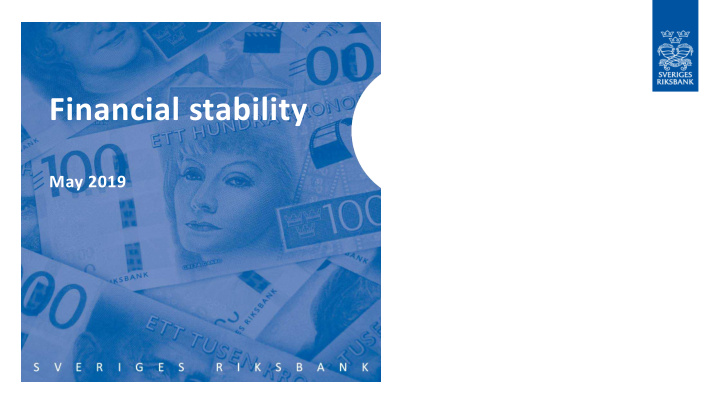



Financial stability May 2019
Household indebtedness remains the greatest risk... Total household debt as a share of annual disposable household income added together over the Sources: Statistics Sweden and the Riksbank last four quarters. The broken line represents the Riksbank’s forecast.
... and the high indebtedness is making households sensitive to interest rates Households’ interest expenditure as a share of annual disposable income. The broken line represents the Riksbank’s forecast. The blue field illustrates an interval for interest expenditure that is calculated on the current debt-to- Sources: Statistics Sweden and the Riksbank income ratio, a long-term interval for the repo rate of 2.5–4 per cent and an assumption of a 2 per cent margin between the repo rate and the interest rate faced by households. Interest expenses have been adjusted for tax deductions for interest expenditure.
The housing market functions poorly and the problems need to be managed • Household debt continues to constitute a risk... • ...macroprudential policy measures have made a positive contribution • But it is important that tax and housing policies manage the imbalances between supply and demand on the housing market
Historically high debts among companies Corporate borrowing through securities issues and MFIs as a percentage Source: Statistics Sweden of GDP.
Another situation now than 20 years ago - now there is low national debt but high private indebtedness Per cent of GDP. Source: Statistics Sweden
Swedish banks are exposed to the property market • Large exposures to the property market • Dependent on wholesale funding 76% • Large, concentrated and interconnected Refers to the percentage share of lending from Monetary Financial Source: Statistics Sweden Institutions to households and companies that is against collateral in property. Data refers to 2018.
Stress test of the banks' capital • The Riksbank has stress tested the four largest banks in Sweden. • Authorities and banks carry out stress tests using various methods • The Riksbank’s stress test shows that major credit losses may arise • Stress tests complement each other
Banks need to strengthen their resilience Source: European Banking Authority (EBA) Leverage ratios in various countries, per cent, December 2018. Refers to weighted average per country.
Infrastructure needs to increase its resilience to risks • It is important to increase the resilience of the infrastructure systems that the Riksbank monitors • Internationally, cyber risks are seen as one of the greatest threats • Financial systems are often interconnected and dependent on each other, as well as being faster and available for a larger share of the day
Risks abroad may affect financial stability Trade conflicts Brexit Structural problems in the euro area
Vulnerable financial system exposed to risks Reduce risks linked to household indebtedness Strengthen banks’ resilience
Recommend
More recommend